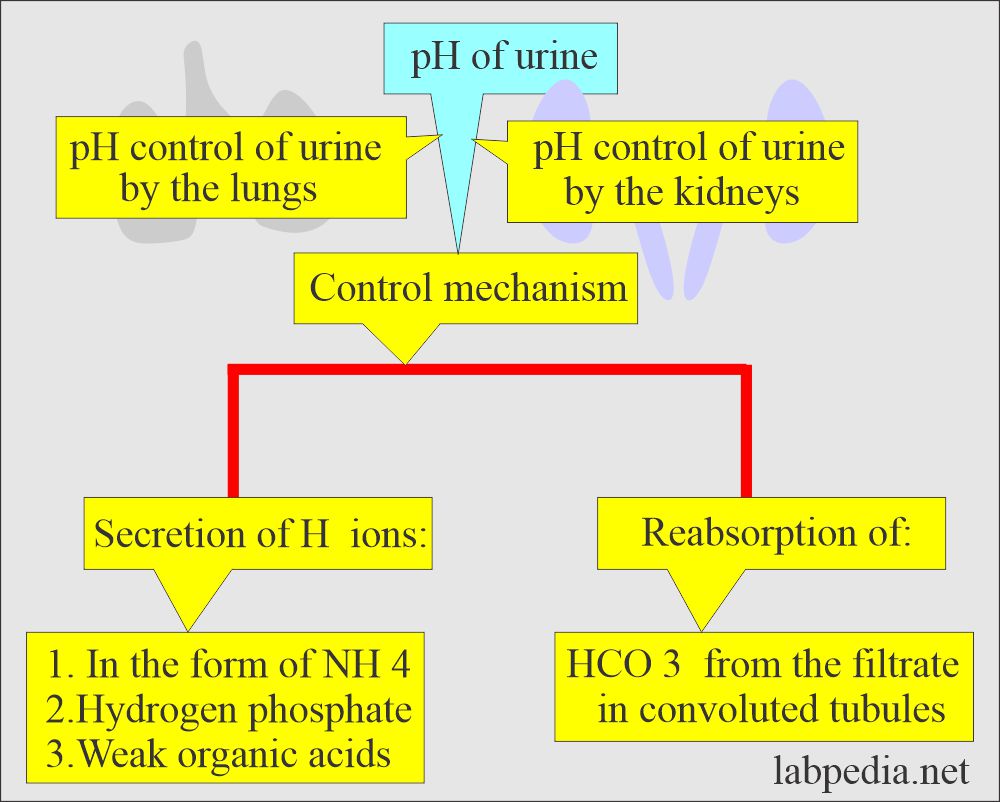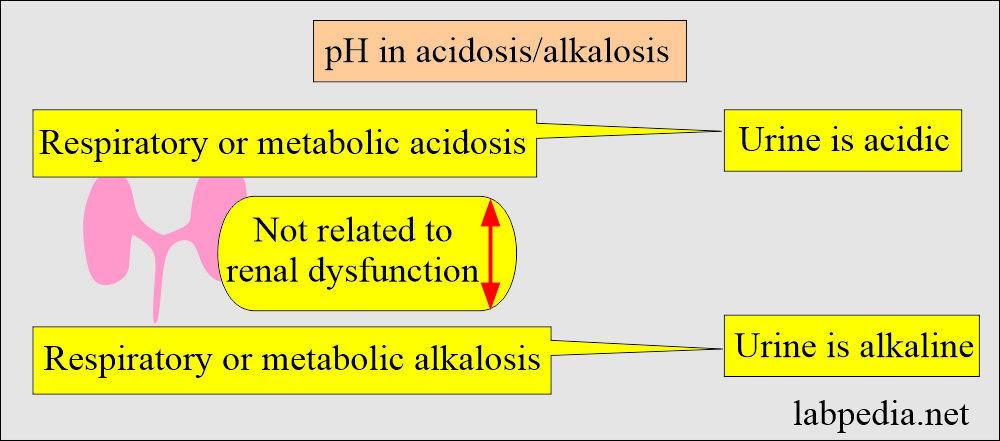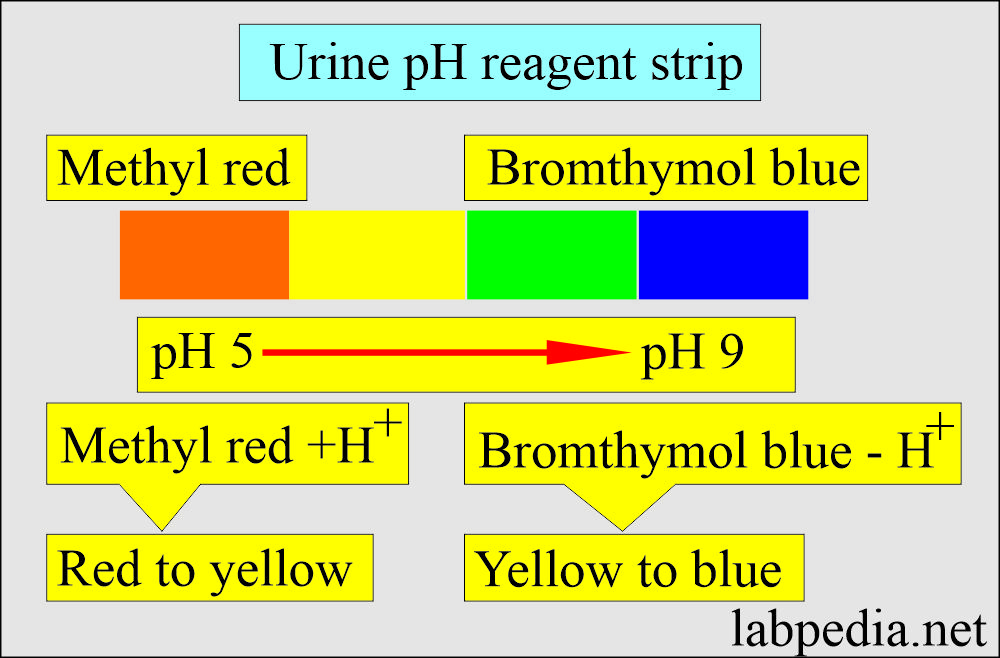Urine pH and Its Significance
Urine pH
Sample for urine pH
- The test sample is urine.
- A fresh urine sample is preferred.
Indications for urine pH
- pH tells the systemic acid-base disorder:
- Is it metabolic?
- Or Respiratory.
- Renal tubular acidosis.
- pH is used to identify the type of crystals.
- Urinary pH is very important in the treatment of renal stones and crystals.
- pH is important in managing diseases, bacteriuria, renal calculi, and drug therapy.
Pathophysiology of urine pH
- The small changes in the urine pH are of little significance.
- The lungs and the kidneys are the major regulators of the acid-base content in the body.
- Lungs and the kidneys maintain the pH and acid-base balance by secretion of H+ ions in ammonium ions, hydrogen phosphate, weak organic acid, and reabsorption of bicarbonate from the filtrate in the convoluted tubules.
- A healthy individual will produce morning urine as acidic with a pH of 5.0 to 6.0.
- Alkaline urine may be found after meals (alkaline tide).
- The random pH ranges from 4.5 to 8.0.
- pH measures the free hydrogen (H+) ions concentration in the urine.
- Urine pH:
- 7.0 = neutral
- < 7.0 = acidic.
- > 7.0 = alkaline.
- Urine pH indicates the renal tubule’s ability:
- To maintain normal H+ concentration in the plasma.
- To maintain the extracellular H+ concentration.
Mechanism of the control of urine pH:
- The kidneys are the major regulator of the acid-base content in the body.
- Renal distal tubules are the most active site for homeostasis for:
- Plasma electrolyte balance.
- Plasma acid-base balance.
- In the distal tubules, there is a combination of secretion and reabsorption of:
- Na+
- K +
- H+
- In the distal tubules, there is an exchange of H+ for Na+.
- Kidneys have the main function of producing alkaline or acidic urine and maintaining constant body pH.
- Kidneys maintain acid-base by absorption of Na and excretion of H and ammonia.
Significance of urine pH:
- In respiratory or metabolic acidosis, when there is no renal dysfunction, the urine will be acidic.
- While in the case of respiratory or metabolic alkalosis, when there is no renal dysfunction, urine will be alkaline.
Hydrogen ions secretion and reabsorption in the kidney are shown in the table:
| Hydrogen ions | Prox. tubule | Loop of Henle | Collecting ducts |
| Secretion | + | + | + |
| Reabsorption | – | – | + |
Common clinical conditions causing alkaline and acidic urine are:
| Alkaline urine formation causative agents | Acidic urine formation causative agents |
|
|
Normal urine pH
Source 2
- Normal pH varies from 4.6 to 8.0 (average 6.0).
Lab measurement of urine pH:
- Test strips were impregnated with the indicator.
- Methyl red in urine pH below 4.2 is red.
- pH above 6.2 is yellow.
- Bromthymol blue is yellow at a pH value below 6.0.
- Blue at the value above 7.6.
- In between the pH, there are shades of orange and green.
- Read after 60 seconds and compare the colors with the given color chart.
- Whereat pH 5 is orange, and at pH 8.5 is blue.
- pH electrodes are more accurate.
High pH > 7.0 urine:
- It Indicates Alkaline urine, maybe due to the following:
- Gastric suction
- Renal Failure
- Vomiting (metabolic acidosis)
- Respiratory alkalosis.
- Hyperventilation.
- Potassium depletion.
- A bacterial infection like Proteus and Pseudomonas.
Low pH < 7.0 urine:
- It indicates Acidic urine, maybe due to the following:
- Metabolic acidosis.
- A bacterial infection like E.coli.
- Renal tuberculosis.
- Fever.
- Diabetic ketosis.
- Diarrhea.
- Starvation.
- Uremia.
Causes of acid and alkaline urine:
| Alkaline urine | Acidic urine |
|
|
pH urine role in renal calculi:
- The renal stone formation depends upon urine pH.
- Calcium phosphate, calcium carbonate, and magnesium phosphate stones form in alkaline pH, so keep the urine acidic to prevent their formation.
- Uric acid, calcium oxalate, and cystine form in acidic urine; to prevent their formation, keep the urine pH alkaline.
pH urine role in drug therapy:
- Neomycin, kanamycin, and streptomycin are effective in alkaline urine.
- Salicylate intoxication keeps the urine pH alkaline.
- Sulfa therapy forms crystals and these can be prevented by keeping urine pH alkaline.
pH urine role in diseases:
- Keep urine pH acidic during :
- The treatment of urinary tract infection.
- In persistent bacteriuria.
- In renal calculi, which develop in alkaline urine.
Diet effect on the urine pH:
- Vegetarian diet, citrus fruits keep urine alkaline.
- A diet rich in protein (meat) keeps urine acidic.
- Cranberry juice keeps urine acidic, and some believe it is a remedy for UTIs.
Summary of the significance of the urine pH:
- For assessment of metabolic alkalosis and acidosis.
- For assessment of respiratory alkalosis and acidosis.
- To find an unsatisfactory urine specimen.
- Urinary pH is important in the management of renal stones or crystals.
- Uric acid stones precipitate in acidic urine and are soluble in basic urine.
- Alkaline urine will precipitate calcium or calcium phosphate, and acidic urine will dissolve these stones.
- Role in the formation of renal calculi.
- Role of pH in the differentiation of the crystals in the urine.
- pH importance in the treatment of urinary tract infection.
- Alkaline urine is needed for the treatment of sulfonamide, and streptomycin therapy to prevent the precipitation of these drugs in the kidneys.
- Alkaline pH is needed during blood transfusion and salicylates intoxication.
- In the case of cystitis, pH is kept acidic to fight bacterial infection and to prevent the formation of alkaline stones.
- Role of pH in renal tubular acidosis.
| Summary of urinary pH in various conditions |
|
Acidic and alkaline urine mechanism and etiology:
| Characteristics | Etiology | Mechanism |
| Acidic urine | ||
|
|
|
|
Seen in:
|
|
|
|
|
| Alkaline urine | ||
|
|
|
|
|
|
|
|
|
|
Prevents crystalization of:
|
|
|
It is seen in:
|
|
|
|
|
Normal urine picture:
| Physical features | Chemical features | Microscopic findings |
|
|
|



